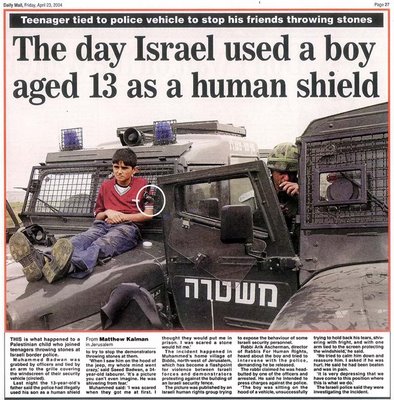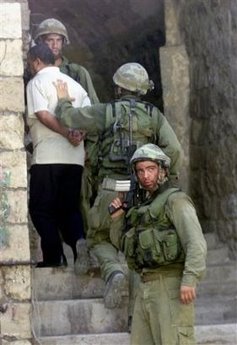
22 April 2004
"A photograph of a Palestinian boy tied to an Israeli police jeep has been handed to justice officials charged with investigating complaints over the use of "human shields" against demonstrators.
The boy, 13-year-old Mohammed Bedwan, and three adult protesters were tied to border police vehicles last week during one of what have become almost daily demonstrations against the routing of the Israeli government's barrier through Palestinian land.
The photograph, taken by human rights activists in the village of Biddo, north-west of Jerusalem, shows Mohammed tied by an arm to a mesh on the jeep windscreen - a mesh intended to protect the vehicle and its driver against stones and rocks. Police said last night that the Justice Ministry's police complaints unit was investigating the case."

Photo: An Israeli soldier leans his hand on the back of a handcuffed unidentified Palestinian resident as he is made to enter before the soldiers inside a building during a search operation in the Old City of the West Bank town of Nablus, in this Sunday, Aug. 24, 2003 file photo.


17 May 2005
Sixteen-year-old Fadi Sharha of Dura, used as a human shield after being arrested by Israeli soldiers during a clash with Palestinian youths in Hebron. Photo: Nayef Hashlamoun, and B'Tselem.
Israelis accused of 'human shields' tactic
The three brothers were blindfolded, says Hazem, and their hands tied behind their backs. He shows me the wounds on his wrists from the plastic handcuffs - still sore and infected, but beginning to heal over. He shows me where the soldiers positioned them: outside the entrance to his flat on the third floor, in the stairwell, facing down the steps.
"I think they put us here because they were expecting suiciders to come into the flat because none of the soldiers were on the stairs - they were all inside the flat. They put us here so we'll be shot first."
Inside the flat, the soldiers punched holes in the walls of his living room, and bedroom. Through them, snipers exchanged fire with Palestinian militants. Hazem and his brothers heard it all, but could see nothing. Hazem says he had little idea at the time exactly how long he was kept there. All he remembers was listening to the heavy gunfire around him, and counting the calls to prayer as they echoed over the area: one at lunchtime, one at tea-time, and one in the evening as the sun set. Twelve hours in all.
He says he expected to die any second. He still can't understand why, as civilians, they couldn't be kept in a room somewhere inside the house, where they would have been safer. But they put us in the middle of the clashes, he says. "There was no need for that." 25 July 2006
BBC
If Hezbollah are using civilians as human shields, and I can find no substantiated reports that they are, quite the opposite in fact, it would appear that they certainly don't have a monopoly on the tactic.
No comments:
Post a Comment